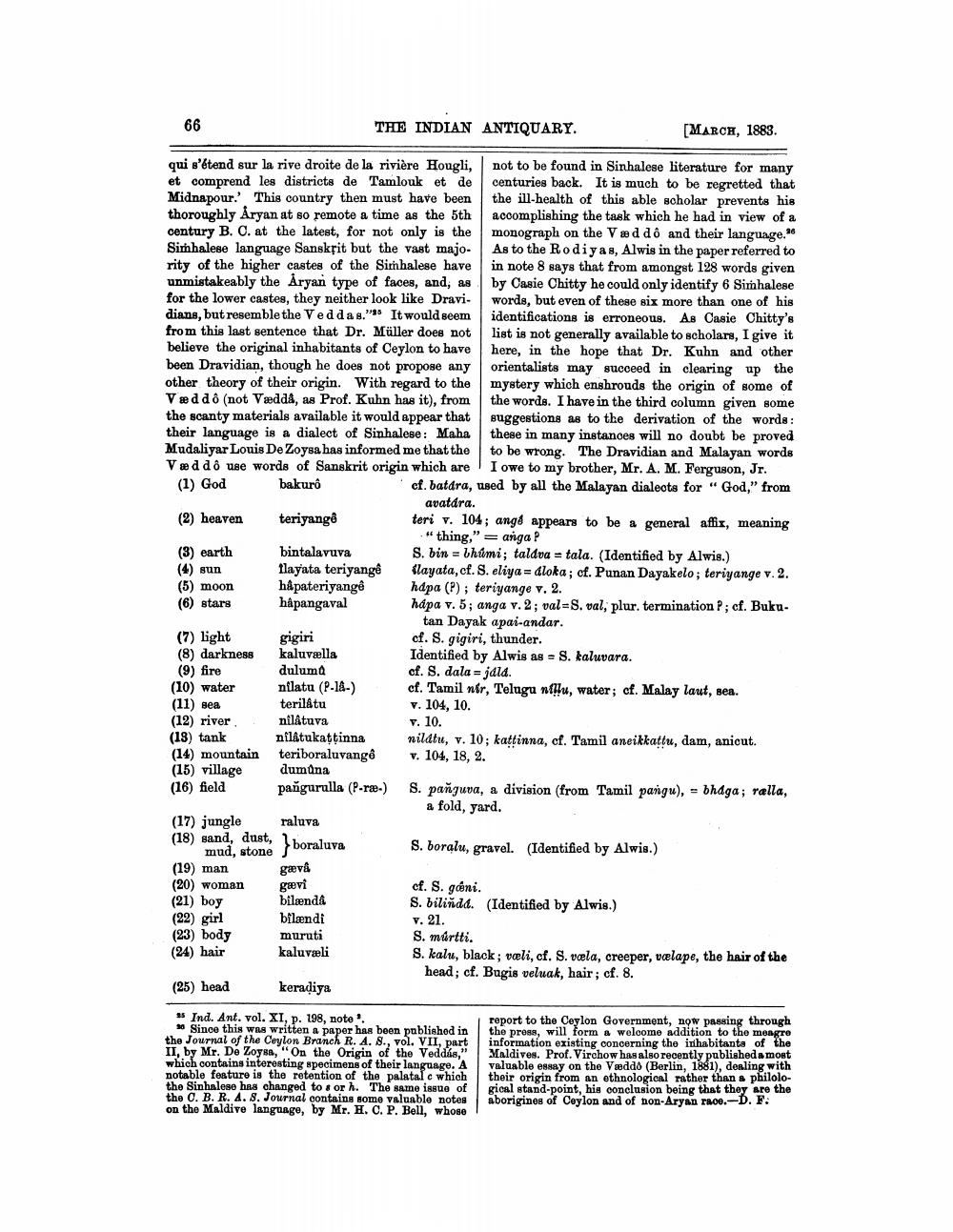________________
66
THE INDIAN ANTIQUARY.
[MARCH, 1883.
qui s'étend sur la rive droite de la rivière Hougli, not to be found in Sinhalese literature for many et comprend les districts de Tamlouk et de centuries back. It is much to be regretted that Midnapour.' This country then must have been the ill-health of this able scholar prevents his thoroughly Aryan at so remote a time as the 5th accomplishing the task which he had in view of a century B. C. at the latest, for not only is the monograph on the Væddô and their language." Sinhalese language Sanskrit but the vast majo. As to the Rodiyas, Alwis in the paper referred to rity of the higher castes of the Sinhalese have in note 8 says that from amongst 128 words given unmistakeably the Aryan type of faces, and, as by Casie Chitty he could only identify 6 Sinhalese for the lower castes, they neither look like Dravi. words, but even of these six more than one of his dians, but resemble the Veddas." It would seem identifications is erroneous. As Casie Chitty's from this last sentence that Dr. Müller does not list is not generally available to scholars, I give it believe the original inhabitants of Ceylon to have here, in the hope that Dr. Kuhn and other been Dravidian, though he does not propose any orientalists may succeed in clearing up the other theory of their origin. With regard to the mystery which enshrouds the origin of some of Vredd 8 (not Vædda, as Prof. Kuhn has it), from the words. I have in the third column given some the scanty materials available it would appear that suggestions as to the derivation of the words: their language is a dialect of Sinhalese: Mahathese in many instances will no doubt be proved Mudaliyar Louis De Zoysa has informed me that the to be wrong. The Dravidian and Malayan words Vædd o use words of Sanskrit origin which are I owe to my brother, Mr. A. M. Ferguson, Jr. (1) God bakurê
cf. batara, used by all the Malayan dialeots for "God," from
avatdra. (2) heaven teriyangê
teri v. 104; angå appears to be a general affix, meaning
"thing," = anga P (3) earth bintalavuva S. bin = bhúmi; taldva = tala. (Identified by Alwis.) (4) sun Ilayata teriyangê layata, cf. S. eliya = dloka; cf. Punan Dayakelo; teriyange v. 2. (5) moon hâpateriyangê hdpa (?); teriyange v. 2. (6) stars håpangaval hapa v. 5; anga v. 2; val=S. val, plur. termination P; cf. Buku
tan Dayak apai-andar. (7) light gigiri
cf. S. gigiri, thunder. (8) darkness kaluvalla
Identified by Alwis as = S. kaluvara. (9) fire duluma
cf. S. dala = jdid. (10) water nilatu (P-18-) cf. Tamil nir, Telugu w u, water; cf. Malay laut, sea. (11) sea terilatu
v. 104, 10. (12) river nilåtuva
v. 10. (18) tank nilatukattinna nilatu, v. 10; kattinna, cf. Tamil aneikkattu, dam, anicut. (14) mountain teriboraluvangê v. 104, 18, 2. (15) village dumuna (16) field paňguralla (P-ræ.) S. pañguva, a division (from Tamil pangu), = bhaga; ralla,
a fold, yard. (17) jungle raluva (18) sand, dust, boraluva mud, stone
S. boralu, gravel. (Identified by Alwis.) (19) man (20) woman gævi
cf. S. geni. (21) boy bilænda
S. bilindt. (Identified by Alwis.) (22) girl bilændi
v. 21. (23) body muruti
S. múrtti. (24) hair kaluvali
S. kalu, black; væli, cf. S. vola, creeper, vælape, the hair of the
head; cf. Bugis veluak, hair ; cf. 8. (25) head keradiya
gæve
* Ind. Ant. vol. XI, p. 198, note.
Since this was written a paper has been published in the Journal of the Ceylon Branch R. A.S., vol. VII, part II, by Mr. De Zoysa, "On the Origin of the Veddás," which contains interesting specimens of their language. A notable feature is the retention of the palatalc which the Sinhalese has changed to sor h. The same issue of the 0. B. R. A. S. Journal contains some valuable notes on the Maldive language, by Mr. H.C. P. Bell, whose
report to the Ceylon Government, now passing through the press, will form a weloome addition to the mongo information existing concerning the inhabitants of the Maldives. Prof. Virchow has also recently published a most valuable essay on the Væddo (Berlin, 1881), dealing with their origin from an ethnological rather than a philological stand-point, his conclusion being that they are the aborigines of Ceylon and of non-Aryan race.-D. F.




